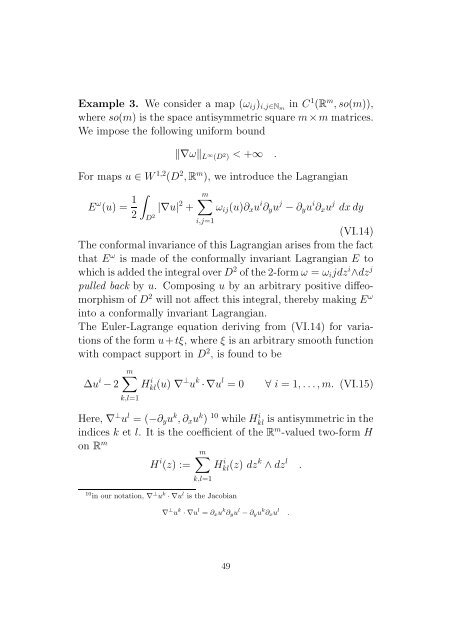Conformally Invariant Variational Problems. - SAM
Conformally Invariant Variational Problems. - SAM
Conformally Invariant Variational Problems. - SAM
You also want an ePaper? Increase the reach of your titles
YUMPU automatically turns print PDFs into web optimized ePapers that Google loves.
Example 3. We consider a map (ω ij ) i,j∈Nm in C 1 (R m ,so(m)),<br />
where so(m) is the space antisymmetricsquare m×m matrices.<br />
We impose the following uniform bound<br />
‖∇ω‖ L∞ (D 2 ) < +∞ .<br />
For maps u ∈ W 1,2 (D 2 ,R m ), we introduce the Lagrangian<br />
E ω (u) = 1 ∫ m∑<br />
|∇u| 2 + ω ij (u)∂ x u i ∂ y u j −∂ y u i ∂ x u j dxdy<br />
2 D 2 i,j=1<br />
(VI.14)<br />
The conformalinvariance of this Lagrangianarises from the fact<br />
that E ω is made of the conformally invariant Lagrangian E to<br />
whichisaddedtheintegraloverD 2 ofthe2-formω = ω i jdz i ∧dz j<br />
pulled back by u. Composing u by an arbitrary positive diffeomorphism<br />
of D 2 will not affect this integral, thereby making E ω<br />
into a conformally invariant Lagrangian.<br />
The Euler-Lagrange equation deriving from (VI.14) for variations<br />
of the form u+tξ, where ξ is an arbitrary smooth function<br />
with compact support in D 2 , is found to be<br />
∆u i −2<br />
m∑<br />
Hkl(u) i ∇ ⊥ u k·∇u l = 0<br />
k,l=1<br />
∀ i = 1,...,m. (VI.15)<br />
Here, ∇ ⊥ u l = (−∂ y u k ,∂ x u k ) 10 while Hkl i is antisymmetricin the<br />
indices k et l. It is the coefficient of the R m -valued two-form H<br />
on R m m∑<br />
H i (z) := Hkl i (z) dzk ∧dz l .<br />
k,l=1<br />
10 in our notation, ∇ ⊥ u k ·∇u l is the Jacobian<br />
∇ ⊥ u k ·∇u l = ∂ x u k ∂ y u l −∂ y u k ∂ x u l .<br />
49
















